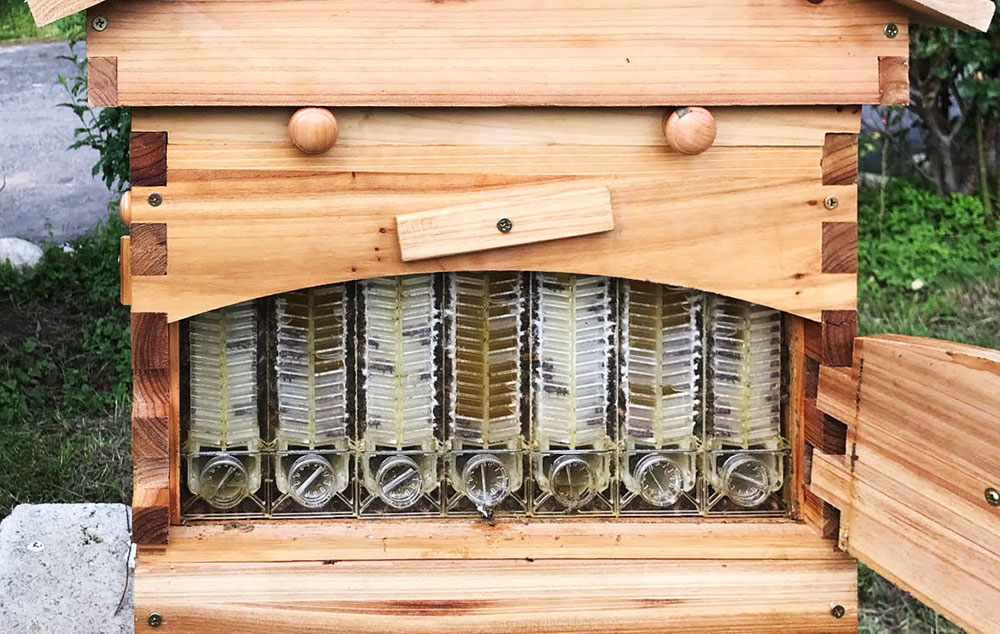Sherab Lhamo
Six dzonkhags have procured Flow Hive technology with the help of the Ministry of Agriculture and Livestock (MoAL) and United Nations Development Programme (UNDP).
The Flow Hive is clean and hygienic compared to the conventional way, which involves removing the honeycomb and extracting.
The technology also makes honey extraction less disruptive for both beekeepers and the bees, as there will be no deaths of bees, said Dr Jambay Dorjee, the Programme Director of National Livestock Research Centre, Bumthang.
The project, funded by the Government of Japan and UNDP, has supplied 250 numbers of the Flow Hive and other accessories such as honeybee colonies, bee feeds, essential beekeeping equipment, and tools.
The project was implemented on March 20, 2023, and ended on March 19, 2024.
A Flow Hive consists of food-grade plastic honeycomb with vertical gaps in between them. The hive includes a brood chamber (where the queen lays eggs and young bees are raised) and a honey super (a box to store extra honey), queen excluder, flow tube, bottom board, and the key to open the honey frame cells. The hive can hold 10 frames.

Flow Hive technology helps make honey extraction less disruptive for both beekeepers and the bees
Dr Jambay said Flow Hive technology has several advantages, including helping to reduce manpower, as the traditional bee house required more people to smoke bees out, and extract honey. The honey in Flow Hive, when the key unlocks honey frames, a flow tube channels honey directly from the hive into jars.
The Flow Hives, imported from India and China, are provided in six Dzongkhags, including Bumthang, Gasa, Thimphu, Trongsa, Haa, and Wangdue.
The Flow Hive project, titled, “Promoting technologically enabled Agriculture for vulnerable farming population in Bhutan,” was supported by the Government of Japan, which provided USD 1.5 million grant, and USD 35,000 from UNDP, implemented by the MoAL and UNDP Bhutan.
The Flow Hive and its accessories are on a cost-sharing basis of 70:30. Each Flow Hive technology costs Nu 37,200. From that, beekeepers paid Nu 11,160 per hive and the project paid Nu 26,040. For the honeybee colonies costing Nu 11,500, beekeepers paid Nu 3,450, and the project paid Nu 8,050. Honeycomb is naturally formed within any traditional or Flow Hives once they are colonised by bees.
The disadvantage of Flow Hive was, it could not be used at commercial levels, as honey passes through pipes into honey jars. Dr Jambay said it can be solved if beekeepers procure pipelines that help extract it into drums. Another issue was the suitability of Flow Hives in tropical and subtropical regions where the beekeepers rear the bees. As those local species of Apis cerana bees were small in size, this could be solved by modifying and reducing the size of the Flow Hive.
The bees in other regions are called Apis mellifera bees, which are big in size, and Flow Hives are designed for them.
Dr Jambay said that as the first few months were spent in tendering, procuring, and distribution, winter came around, and at that time, the bees were left untouched. So, production will only start from June or July. The bees are currently in the traditional bee house, and they plan to transfer them into the Flow Hives.
There are 20 Flow Hives at the research centre in Bumthang, kept as institutional demonstrations.
Flow Hive was first launched in 2015 in Australia and was invented by Stuart Anderson and Cedar Anderson.


